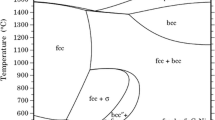Abstract
A sulfidation/carburization study of seven commercial heat-resistant alloyswas carried out at 900°C in a H2–25 vol.%CH4–14.8N2–4CO–0.6CO2–0.6H2Satmosphere. The equilibrium partial pressures for oxygen (O2) andsulfur (S2) were 1.1×10−22 and 4.1×10−8 atm,respectively, and the carbon activity for this system was unity. The time ofexposure was 500 hr. Relatively thick, mixed sulfide scales were formed onall of the alloys tested. In addition, internal carburization occurred inall of the alloys. Using metal loss (i.e., the reduction in samplethickness) plus internal attack (internal sulfidation plus internalcarburization) as a performance criterion, an alloy with a nominalcomposition of Ni–29 wt.% Co–28Cr–2.75Si performed thebest, showing 0.71 mm of attack. An alloy with a nominal composition ofFe–20 wt.% Ni–25Cr performed the worst, being totally consumedby the test (>3.18 mm of attack). Alloys containing relatively highamounts of silicon (>2.5%) showed a dramatic increase in theirsulfidation resistance compared to the other alloys containing lowersilicon contents. The amount of iron present within a given material playeda dominant role in the carburization attack that occurred, with as expected,high-iron alloys showing significant internal carburization because of ahigh solubility and diffusivity of carbon in the matrix. The importance ofthe various alloying elements with respect to sulfidation and carburizationresistance is discussed.
Similar content being viewed by others
REFERENCES
G. Y. Lai, High Temperature Corrosion of Engineering Alloys (ASM International, Materials Park, OH, 1990), p. 117.
G. Sorell and W. B. Hoyt, Collection and Correlation of High Temperature Hydrogen Sulfide Corrosion Data, NACE publ. 56-7, 1956.
G. Sorrell, Compilation and Correlation of High Temperature Catalytic Reformer Corrosion Data, NACE publ. 58-2, 1957.
E. B. Backensto, Corrosion in Catalytic Reforming and Associated Processes, Paper presented at the 22nd Midyear Meeting of API's Division of Refining, Philadelphia, PA, May 13, 1957.
S. Mrowec and K. Przybylski, High Temp. Mat. Proc. 6 (1984).
S. Mrowec, Oxid Met. 44, 177 (1995).
D. J. Young, Rev. High Temp. Mat. 4, 299 (1980).
E. B. Backensto and J. W. Sjoberg, Iso-Corrosion Rate Curves for High Temperature Hydrogen-Hydrogen Sulfide, NACE publ. 59-10, 1958.
W. Steinkusch, Werkst. Korros. 30, 837 (1979).
L. H. Wolfe, Mat. Perform., p. 38 (1978).
R. H. Kane, Corrosion/83, Paper 266 (NACE, Houston, TX, 1983).
U. Van den Bruck and C. M. Schillmoller, Corrosion/85, Paper 23 (NACE, Houston, TX, 1985).
S. K. Roy, H. J. Grabke, and W. Weppner, Arch. Eisenhuttenwes. 51, 91 (1980).
C. Steel and W. Engel, AFS Intern. Cast Metals J., p. 28 (1981).
O. Demel, E. Keil, and P. Kostecki, SGAW Rep. no. 2538, Osterreichische Studiengesellschaft fur Atomenergie.
H. J. Grabke, U. Gravenhorst, and W. Steinkusch, Werk. Korros. 27, 291 (1976).
S. K. Bose and H. J. Grabke, Z. Metallk. 69, 8 (1978).
J. F. Norton and T. P. Levi, Werkst. Korros. 46, 286 (1995).
J. A. Kneeshaw, I. A. Menzies, and J. F. Norton, Werkst. Korros. 38, 473 (1987).
S. M. Watson, Mixed Internal Oxidation of Commercial Heat-Resistant Alloys in Carbon, Sulphur, and Oxygen Containing Environments, Master Thesis, University of New South Wales, School of Materials Science and Engineering, Sydney, Australia, p. 133.
M. Schulte, A. Rahmel, and M. Schütze, Oxid Met. 49, 33 (1998).
D. B. Rao and H. G. Nelson, Oxid Met. 12, 111 (1978).
P. Castello, Y. Niu, F. Gesmundo, and F. H. Stott, Oxid. Met., submitted for publication.
J. F. Norton, private communication, 1998.
J. A. Colwell and R. A. Rapp, Met. Trans., 17A, 1065 (1986).
C. S. Giggins and F. S. Pettit, Oxid. Met. 14, 363 (1980).
M. F. Stroosnijder, V. Guttmann, and J. H. W. de Wit, Werkst. Korros. 41, 503 (1990).
D. J. Young and S. Watson, Oxid Met. 44, 239 (1995).
G. Y. Lai, in High Temperature Corrosion in Energy Systems, M. F. Rothman, Ed. (Metallurgical Society of AIME, Warrendale, PA, 1985), p. 227.
M. A. H. Howes, High Temperature Corrosion in Coal Gasification Systems, Final Rep. GRI-8710152, Gas Research Institute, Chicago, August, 1987.
J. F. Norton, M. Maier, and W. T. Bakker, Corrosion/97, Paper 144 (NACE, Houston, TX, 1997).
J. F. Norton and J. Barnes, in Corrosion in Fossil Fuel Systems, I. G. Wright, ed. (Electrochemical Society, Pennington, NJ, 1983), p. 277.
Author information
Authors and Affiliations
Rights and permissions
About this article
Cite this article
Harper, M.A., Cotner, J.P. Mixed Sulfidation/Carburization Attack on Several Heat-Resistant Alloys at 900°C. Oxidation of Metals 53, 427–449 (2000). https://doi.org/10.1023/A:1004698024506
Issue Date:
DOI: https://doi.org/10.1023/A:1004698024506




